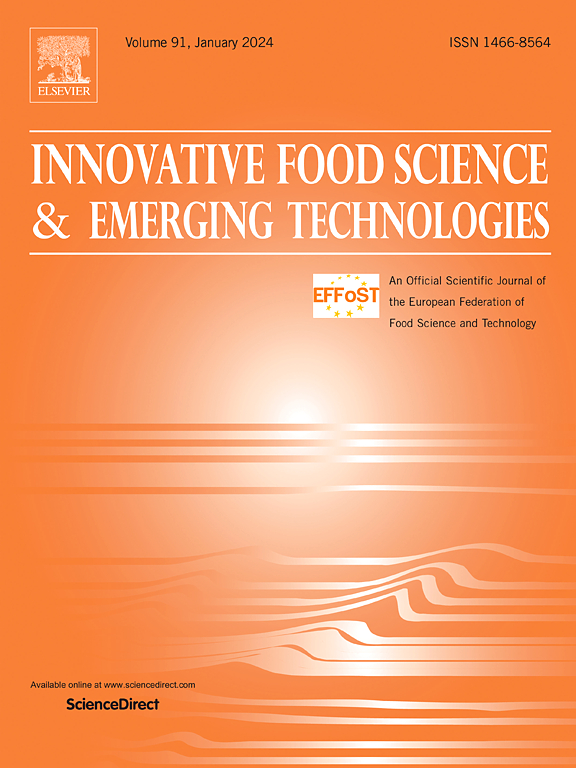Impact of adding dietary fibers and maltodextrin on the mechanical, morphological, optical, barrier and thermal properties of potato starch-based edible films
IF 6.8
1区 农林科学
Q1 FOOD SCIENCE & TECHNOLOGY
Innovative Food Science & Emerging Technologies
Pub Date : 2025-04-02
DOI:10.1016/j.ifset.2025.104012
引用次数: 0
Abstract
The incorporation of prebiotic dietary fibers and maltodextrin into potato starch-based composite films was investigated to evaluate their effects on optical, mechanical, structural, barrier, and thermal properties. The dietary fibers studied included β-glucan, citrus pectin, and chicory inulin with different degrees of polymerization (DP): inulin DP 10 (DP ≥ 10) and inulin DP 23 (DP ≥ 23). For comparison, films were also formulated with maltodextrin and a control containing only potato starch. The results revealed that β-glucan and citrus pectin significantly enhanced the tensile strength (up to 38.53 MPa) and Young's modulus (15.72 ± 2.84 MPa for β-glucan, 12.80 ± 1.68 MPa for citrus pectin), indicating increased rigidity. In contrast, maltodextrin improved film flexibility, as evidenced by the highest elongation at break (12.32 ± 3.33 %) and the lowest Young's modulus (8.76 ± 2.14 MPa). X-ray diffraction showed that β-glucan increased crystallinity, whereas citrus pectin reduced crystallinity, improving compatibility with starch. Films containing inulin, particularly DP ≥ 10, exhibited the highest water solubility (35.72 ± 2.83 %), making them promising candidates for fast-dissolving applications. Thermal analysis revealed that all composite films exhibited higher thermal stability than the control, with maximum decomposition temperatures ranging from 318 °C to 327 °C, compared to 314 °C for the starch-only film. These findings underscore the potential of dietary fiber-enriched edible films for food packaging and functional delivery systems, where enhanced mechanical properties, controlled solubility, and improved thermal stability are desirable.
添加膳食纤维和麦芽糖糊精对马铃薯淀粉基食用薄膜力学、形态学、光学、阻隔性和热性能的影响
研究人员调查了将益生膳食纤维和麦芽糊精加入马铃薯淀粉基复合膜的情况,以评估它们对光学、机械、结构、阻隔性和热性能的影响。所研究的膳食纤维包括不同聚合度(DP)的β-葡聚糖、柑橘果胶和菊苣菊粉:菊粉 DP 10(DP ≥ 10)和菊粉 DP 23(DP ≥ 23)。为了进行比较,还用麦芽糊精和仅含马铃薯淀粉的对照组配制了薄膜。结果表明,β-葡聚糖和柑橘果胶显著提高了拉伸强度(高达 38.53 兆帕)和杨氏模量(β-葡聚糖为 15.72 ± 2.84 兆帕;柑橘果胶为 12.80 ± 1.68 兆帕),表明刚性增强。相比之下,麦芽糊精提高了薄膜的柔韧性,其断裂伸长率最高(12.32 ± 3.33 %),杨氏模量最低(8.76 ± 2.14 兆帕)。X 射线衍射显示,β-葡聚糖增加了结晶度,而柑橘果胶则降低了结晶度,提高了与淀粉的相容性。含有菊粉(尤其是 DP ≥ 10)的薄膜具有最高的水溶性(35.72 ± 2.83 %),因此有望用于快速溶解应用。热分析表明,所有复合薄膜的热稳定性均高于对照组,最大分解温度为 318 °C 至 327 °C,而纯淀粉薄膜的分解温度为 314 °C。这些发现强调了富含膳食纤维的可食用薄膜在食品包装和功能输送系统中的应用潜力,因为在这些应用中,人们需要增强机械性能、控制溶解度和提高热稳定性。
本文章由计算机程序翻译,如有差异,请以英文原文为准。
求助全文
约1分钟内获得全文
求助全文
来源期刊
CiteScore
12.00
自引率
6.10%
发文量
259
审稿时长
25 days
期刊介绍:
Innovative Food Science and Emerging Technologies (IFSET) aims to provide the highest quality original contributions and few, mainly upon invitation, reviews on and highly innovative developments in food science and emerging food process technologies. The significance of the results either for the science community or for industrial R&D groups must be specified. Papers submitted must be of highest scientific quality and only those advancing current scientific knowledge and understanding or with technical relevance will be considered.

 求助内容:
求助内容: 应助结果提醒方式:
应助结果提醒方式:


